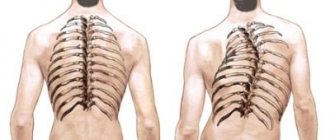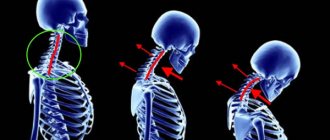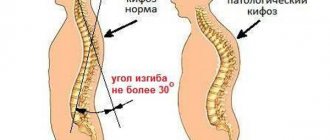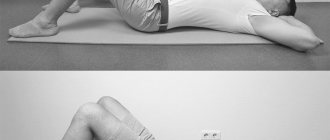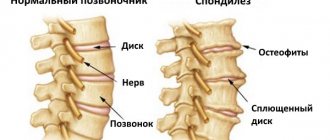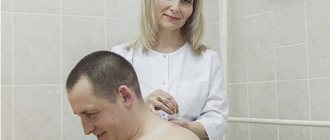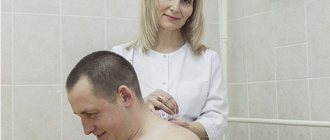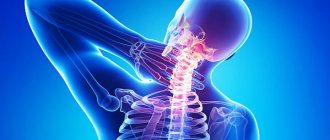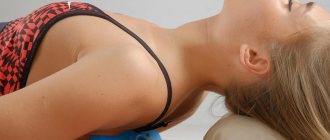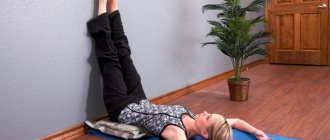Thoracic kyphosis is the most common type of kyphosis, which is characterized by its localization in the thoracic spine. The pathology in this case is the presence of a backward convexity with a deviation angle exceeding 45°. Lack of timely treatment of thoracic kyphosis can lead to hunchback, which not only negatively affects a person’s appearance, but also causes difficulty breathing along with a change in the initial position of the heart.
In order to prevent such life-threatening manifestations, it is necessary to seek timely treatment for thoracic kyphosis. Specialists from the CELT multidisciplinary clinic will help with this. We have extensive experience in this area and have helped many patients return to normal life.
Manual therapy
Treatment of kyphosis with manual therapy is aimed at working out the musculo-ligamentous apparatus and spinal motion segments.
Osteopathic effects on the thoracic spine help normalize myotonus, strengthen the deep muscles that support the vertebral structures, etc. by reducing deformation, eliminate pain symptoms of the disease. During the procedure, mobilization, soft manual techniques and kinesiological techniques are used.
They are selected individually, taking into account the condition, age and physical development of the patient.
Depending on the stage of the disease, we choose one or more treatment methods in Moscow:
Therapeutic massage, osteopathy, manual therapy in Moscow
Helps bones and joints take the correct physiological position, relieves pain and spasms, relaxes muscles.
Acupuncture
Work on biologically active points. It affects the affected area and the body as a whole. Eliminates the cause of the disease and removes the symptoms.
In addition, according to indications, the following are used: taping, pharmacopuncture, FormTotix insoles, exercise therapy with an instructor and other methods. The choice of procedures depends on the current condition; taken together, they act faster and give a more lasting result.
chiropractor chiropractor
Surgery
With a pronounced deviation of the spinal axis of 45-50 degrees or more, the most optimal method is surgical correction. Surgery for kyphosis involves straightening the curvature and bringing it as close as possible to the physiological curve. During surgical intervention, hypoallergenic metal structures are used, attached to the vertebrae using special fasteners. This approach makes it possible to stop further wedge-shaped deformation, prevent damage to internal organs and damage to spinal structures.
How does thoracic kyphosis develop and manifest?
Treatment of this disease is carried out in both adults and children. It is a pathological curvature of the spinal column in the chest area, which has several degrees:
- Light (curvature up to 30°).
- Medium (30–60°).
- Severe (over 60°).
The main cause of the disease is the weakness of the muscular corset that supports the spine, as well as increased loads on this area (usually static). Treatment of such a disorder with the help of kinesitherapy has good results, since it allows you to influence the mechanism of formation of the deformity and helps correct posture without surgery, orthopedic devices and other ineffective methods.
The main signs of the disease are a visually noticeable curvature of the spinal column, as well as back pain, impaired respiratory and digestive functions. Over time, curvature of the spine leads to osteochondrosis, and then to protrusions and hernias.
Exercise therapy and sports for kyphosis
The most important condition for increasing the effectiveness of conservative therapy for Scheuermann-Mau disease is the use of adequate physical activity. The main goal of exercise therapy is the creation of a strong muscle corset and the formation of correct posture. Therapeutic exercises for kyphosis should be used at all stages of deformity. Individually selected exercises prevent muscle atrophy, stimulate tissue trophism and regenerative processes.
Sports that cause active depreciation of the vertebrae (jumping, running, etc.) are strictly contraindicated for patients. Among the permitted and recommended physical activities, swimming for kyphosis should be highlighted. Training should be carried out 2-3 times a week, always combining them with physical therapy. In addition, with the permission of the doctor, every day, for 10-15 seconds, you can exercise (hang or pull up) on the crossbar. The horizontal bar for kyphosis helps strengthen the deep back muscles and slightly stretch the spine.
Cost of treatment for spinal kyphosis
| Services list | Price, rub |
| Appointment (examination, consultation) with an orthopedist - traumatologist, chiropractor, osteopath, kinesiotherapist, test session | 1 600 |
| Kinesi taping 1 zone | 1 100 |
| Magnetic Vacuum Acupuncture | 1 600 |
| Intra-articular Injection (diprospan) | 4 000 |
| Intra-Articular PRP Injection | 6 500 |
| PRP therapy for tendonitis, ligamentitis, contractures | 6 500 |
| Kinesitherapy | |
| Individual lesson with an instructor | 2 700 |
| Individual lesson with a doctor | 3 900 |
| Physiotherapy | |
| UVT session from 5 min to 15 min, 1 unit. body | 2 000 |
| HIVAMAT session up to 15 min, 1 unit. body | 2 200 |
| HIVAMAT session up to 15 min, 2 units. body | 3 200 |
| OSTEOPATHY AND MANUAL THERAPY | |
| Manual therapy 1 department (15 min.) | 2 700 |
| Soft manual techniques (45-60 min.) | 7 500 |
| Osteopathic techniques (30-75 min.) | 7 500 |
Kyphosis of the cervical spine. Diagnosis, treatment
The spine is the support of the entire human skeleton and body. As you know, the shape of the spine is not completely straight, but has several natural bends. It is these bends that provide the shock-absorbing properties of the skeleton. The forward bend of the back in the lumbar and cervical region is called lordosis. A slight protrusion of the spine back in the thoracic and sacral regions is kyphosis.
But sometimes it happens that the natural anatomical deflection of the cervical spine begins to straighten or become flatter. In this case, they talk about kyphosis of the cervical segment. The main cause of the disease may be the development of spinal osteochondrosis, in which the height of the intervertebral discs decreases.
Reasons for straightening the cervical spine
Kyphosis of the cervical spine is observed in patients of different age groups (from infants to the elderly). And this can be a manifestation of the weakness of the muscle corset and the inability to maintain the spine in the correct shape, or a disease of the bone tissue, in which they lose their properties and become more fragile. Therefore, there is a division of the causes of the disease into congenital and acquired.
Congenital:
- Hereditary or congenital kyphosis is characterized by the genotypic transmission of signs of dominant inheritance, in which anomalies in the development of the anterior parts of the vertebrae themselves are observed in several generations.
- To some extent, kyphosis that develops in children of the first year of life suffering from rickets can also be considered congenital. In this case, it occurs due to weakening of the muscles and ligaments of the skeleton and the softness of the vertebral bodies themselves.
- Kyphosis can also be caused by abnormalities in the intrauterine development of the baby or postpartum injuries in newborns.
Purchased:
- Age-related changes in the structure of the vertebral bodies or intervertebral discs.
- diseases of the spine (osteochondrosis, osteoporosis, spondylosis, etc.).
- Traumatic injuries to the spine or muscles and ligaments of the back.
- Constant incorrect body posture (scoliosis), insufficient physical activity or, conversely, excessive stress.
- A peculiar manifestation of Scheuermann-Mau disease is considered to be kyphosis, which develops in adolescence in young men.
- Various severe inflammatory and infectious diseases.
- Tuberculous changes in the structure of the vertebral bodies (their destruction and compression).
- Tumor formations of varying quality in the spine or in soft tissues in direct contact with the spinal column.
Symptoms and diagnosis of kyphosis of the cervical spine
Kyphosis of the cervical segment of the back is usually accompanied by pain in the pathological area, muscle spasms, decreased motor ability or discomfort. Since the main circulatory and nervous structures of the body pass through the cervical region, the disease can manifest itself as frequent headaches, dizziness, visual and hearing impairment, and surges in blood pressure. And also from neuralgia - numbness, loss of sensitivity or tingling in the lower jaw or the back of the head.
To confirm the diagnosis and determine the degree of development of the disease, the attending physician prescribes an x-ray of the spine. Moreover, two projections are made at once (lateral and direct). For a more detailed study of pinched nerves or blood vessels, a computed tomography or MRI of the cervical spine is prescribed. Next, the doctor tries to more accurately identify the root cause of the disease and prescribe appropriate treatment, taking into account all the collected indicators and structural features of the patient’s body.
treatment of kyphosis of the cervical spine
Like other spinal diseases, kyphosis does not heal in a week or two. This process is lengthy and requires special concentration of the patient on his own condition and strict adherence to the doctor’s recommendations.
As a rule, conservative treatment methods are used to treat kyphosis of the cervical spine. They involve the use of analgesics (to relieve pain), anti-inflammatory drugs, drugs that help relax muscle spasms, improve blood circulation and antidepressants (to improve the patient’s general nervous condition). At the same time, treatment or elimination of the causes that caused the progression of the disease is carried out.
In especially severe cases, surgical intervention or prosthetics with metal plates can be used (they are fixed directly to the body of adjacent vertebrae in the pathological area and are removed after some time). Specialized orthopedic collars and corsets are also widely used. Next, physical therapy courses, physiotherapy, swimming, etc. are prescribed.
Non-traditional methods of treating kyphosis, such as general massage, manual therapy of the spine, acupuncture, reflexology, etc., have shown good results.
Good prevention of the disease is considered to be: regular physical activity, morning exercises, and maintaining an active lifestyle. It is advisable to monitor your posture (correct body position while walking, sitting, sleeping). In addition, swimming, aerobics, and yoga will be very useful.
Prevention of kyphosis of the cervical spine
Performing a simple set of therapeutic and preventive gymnastics will also help to avoid kyphosis:
Exercise 1
The exercises can be performed both sitting and standing, the main thing is to ensure correct posture. Shoulders are turned, back is straight, hands are placed on the belt. We move our head, pulling it forward, while not lowering the chin to the chest, but smoothly pulling it parallel to the floor, feeling the stretching of the neck muscles. We take a deep breath, and as we exhale we return our head to its original position and try to pull our chin into our neck. At the same time, we do not bend our neck. Initially, we do the exercise 5-8 times.
Exercise 2
We turn our heads to the side. When turning, we inhale slowly, slightly holding our breath, and stretch our chin to our shoulder, without lowering our chin down, but simply moving it in a horizontal plane. Exhaling, we return our head to its original position, and then rotate while inhaling in the opposite direction. Repeat 5-8 times.
Exercise 3
We bend our head forward while inhaling. At the same time, we try to place the chin as close to the chest as possible. We return to the starting position and immediately, while exhaling, slowly tilt the head back. We do the exercise very carefully so as not to cause pain. Repeat 5-8 times.
Exercise 4
We turn our head slowly to the side, take a breath and try to look at the buttock, slightly lowering our head down. As you exhale, we return to the starting position and do the same in the opposite direction. In this case, the movements should be performed slowly and relaxed, causing more stretching of the muscles than their tension and stiffening. Repeat 5-8 times.
Exercise 5
We lower our head a little down, about 45o, the back and shoulders remain in place. Next, we turn our heads first in one direction or the other, trying to look at the sky. Repeat 5-8 times.
Exercise 6
We perform a lateral tilt of the head to the side while inhaling, fix the state for a short time, then stretch the crown of the head slightly up and to the side. At the same time, we do not press our head against our shoulder, but simply stretch our head further along the axis of the bend. As you exhale, we return to the starting position and do the same in the opposite direction. Repeat 5-8 times.
Exercise 7
We pull the chin towards the neck, then turn the head to the side, stretch the chin, draw an arc along the horizontal plane to the opposite shoulder. Then we press the chin back into the neck and return to the starting position. To make it easier, imagine a saucer located under your chin and describe its edges. The exercise must be performed in a horizontal plane. Then the revolutions are performed in the opposite direction. We perform 5-8 times in each direction.
Exercise 8
Next, we perform slow and smooth circular movements with our heads. We fix each intermediate state by stretching the neck. Tilting towards the shoulders, we stretch the top of the head up and to the side along the plane of the shoulder. Smoothly move your head down in a circle, again fix the position and stretch with the top of your head, stretching the neck muscles. Then to the other shoulder and back, stretching in each position. Then we perform the exercise in the other direction.
The set of exercises is quite simple, it lasts 10-15 minutes.
After some time, the number of repetitions can be gradually increased. It is mainly aimed at stretching the muscles of the neck corset rather than pumping it up, and is more reminiscent of yoga. Daily exercise will show a significant improvement in the patient’s condition within a month, and after two to three months it can completely restore the anatomical natural curves of the spine. Author: K.M.N., Academician of the Russian Academy of Medical Sciences M.A. Bobyr
Causes of kyphosis
Factors in the development of kyphosis are divided into primary and secondary. Primary refers to disorders of intrauterine development and injuries during childbirth.
Secondary causes include:
- vitamin D deficiency. Deficiency leads to disturbances in the development of the skeletal system, which causes poor posture in childhood;
- infection. Bone tuberculosis and ankylosing spondylitis cause destruction of the structure of the vertebrae and intervertebral discs, which leads to poor posture;
- age-related changes. Over time, the structure of the intervertebral discs changes; if at the age of 40-45 years there are disturbances in the spine, they may worsen;
- curvature of posture. If you sit in an incorrect position or stay in one position for a long time, the vertebrae gradually become curved. Also, a risk factor may be a mattress that is too soft and does not provide the desired supporting effect;
- diseases of the spine. Kyphosis may be a secondary factor in changes in spinal structure. When osteochondrosis or hernia occurs, the back muscles are pinched. As a result, a person unconsciously tries to minimize pain and assumes an incorrect position.
Most cases of kyphosis occur during adolescence. Children often sit in the wrong position at school, which leads to the formation of kyphosis. Against the background of the not yet completed process of skeletal formation, the curvature worsens.
Treatment
In the initial stages of kyphosis, the spine can be treated with conservative methods. The patient is prescribed massage, physical therapy, physiotherapy, and corset therapy. Painkillers, anti-inflammatory drugs, and medications to reduce swelling may be used to reduce pain.
Physiotherapy
This concept includes a wide list of techniques. The purpose of physiotherapy is to activate blood circulation in the muscles, relieve spasms, and reduce pain. As part of the treatment course, the patient is prescribed electrophoresis, magnetic therapy, laser therapy, and shock wave treatment. Contraindications are heart failure and the presence of metal implants.
Massage
A course of massage is one of the most effective methods of treating kyphosis. During the massage, not only the back affected by kyphosis is worked on, but also the chest and abdominal area. The frontal part also requires massage, as the muscles in this area begin to atrophy, blood circulation slows down, which negatively affects the functioning of the internal organs. The massage technique should be special, without affecting the vertebrae themselves, as they may be susceptible to destruction by osteochondrosis or hernia. Massage is carried out in courses and is recommended for use as a preventive measure throughout life.
Exercise therapy
A special set of exercises allows you to expand the chest area and reduce the amount of curvature of the spinal column. All exercises are performed slowly with a gradual increase in intensity.
Exercises to treat kyphosis:
Corset therapy
The pronounced effect provides a static effect on the curved spine. For this purpose, wearing a special corset is prescribed, which helps to move the shoulders back and straighten the posture. The corset relieves tension from the muscles and gives the body the correct position. Doctors recommend wearing such a corset for a fixed amount of time per day. After a certain period of time, a person gets used to maintaining correct posture.
If conservative methods do not give the desired effect or treatment is started at a late stage, a decision is made about surgery. The curvature is corrected and the vertebrae are fixed with special screws. The peculiarity is that the disease can return if the patient does not continue to monitor his posture and perform exercises.
Classification of kyphosis
There are several criteria by which kyphosis is classified. This is a definition of types in terms of degrees of formation, location of the apex of the bend along the entire length of the spine, and time of appearance.
Types by time of appearance:
- kyphosis of infancy;
- teenage form;
- kyphosis in adulthood;
- senile kyphosis.
Types by summit location:
- kyphosis of the cervical spine;
- upper thoracic region;
- in the region of the heart;
- in the lower part of the thoracic region;
- on the periphery of the chest and lower back;
- in the lumbar spine.
The most common form of the disease is thoracic curvature. Primarily because poor posture as a result of incorrect body position, osteochondrosis and age-related changes that cause deformation of the sternum area are common to a large number of people.
